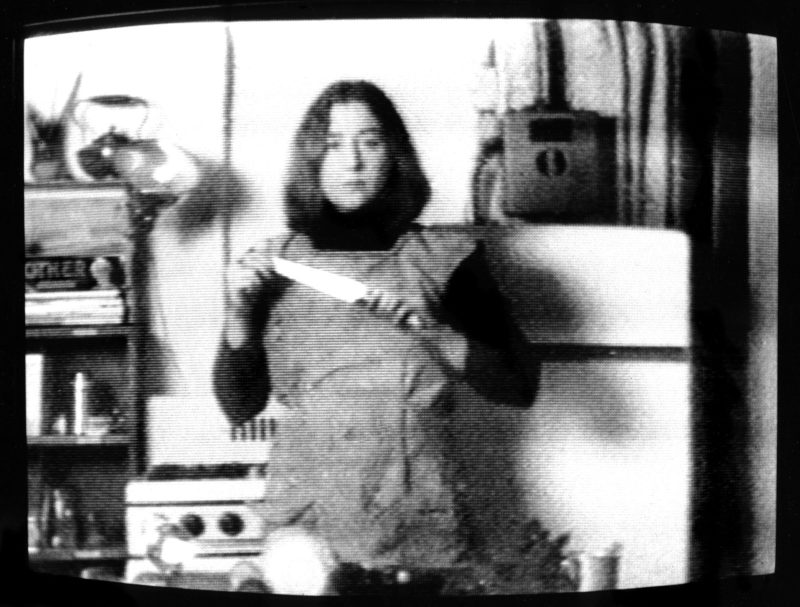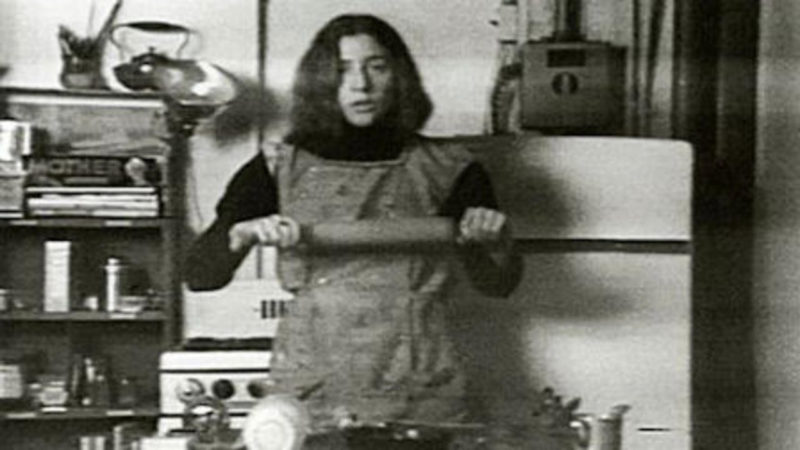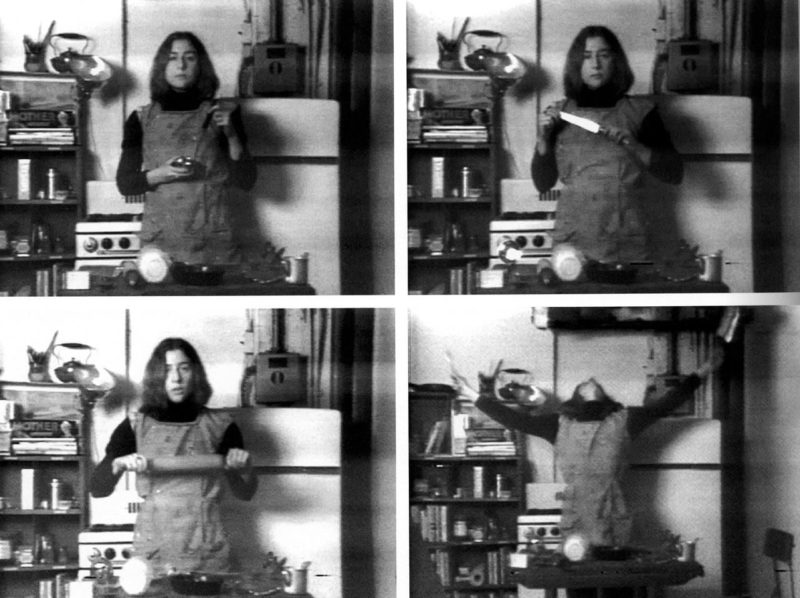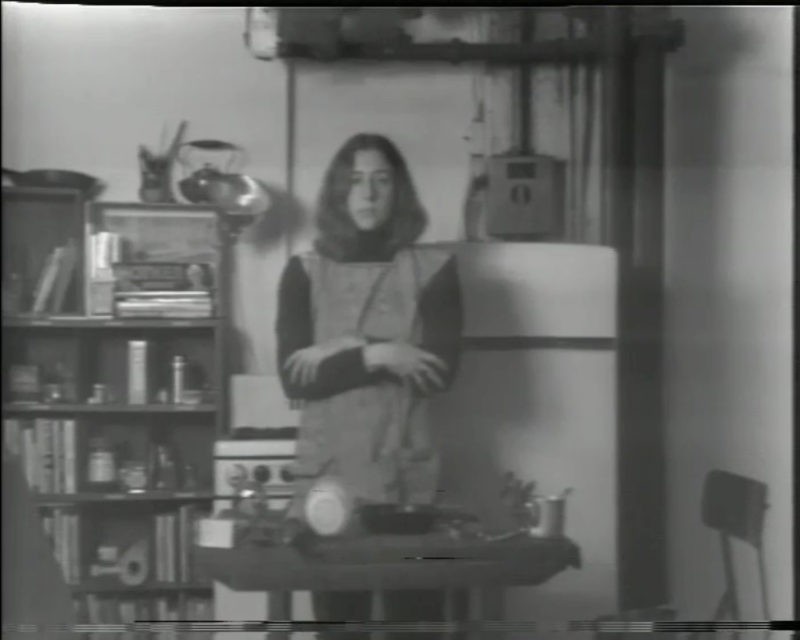
Introduction
Semiotics of the Kitchen is a work by Martha Rosler 1. She produced it in 1975 by using an alphabet worth of kitchen tools to participate in a feminist 2 critique of the traditional role of gender.
Her acts in the 6 minutes recording are characterized by frustration and anger at the patriarchal role of women. Rosler relies on the philosophy of semiotics, which implies that words are simply indicators of social interactions that human beings use to describe their world. She recorded all of this in a similar format to TV shows in the 1960s.

What does it show?
In a kitchen setting, the video shows Rosler. She gathers every utensil on her own and declares each name; egg beater, fork, grater, etc. Rosler does not view the kitchen tools as the ‘helper’ of a domesticated mother. Instead, it poses a challenge for her.
Rosler begins explaining the alphabetical order of kitchen utensils in the manner of a seemingly simple TV-style segment (from’ apron’ to’ tenderizer’). The work then leads to a performance whose critical edge comes not only from the exact analytical and emphatic understanding of the subject by the artist but also from the formal structure of his acting.
Analysis
In the video, she shows apparent defiance of the prevailing male-dominated society in which she lives by acting through aggression. Rosler is eager to distinguish herself from the image of a housewife. For example, when she holds a knife, she opposes the intended action that is commonly used when she stabs the air like a cold-blooded murderer.
To label the exploitation and thus consider the conceptions of femininity, Rosler chooses what seems to be the lingual of a woman. The black and white video of Martha Rosler’s Semiotics of the Kitchen shows her displaying the kitchenware and its tasks with sudden and aggressive motions.
The artist discusses the aggressiveness of the Woman in the Kitchen, whether from outside or from inside, in the supremely anarchic and comical presentation. She stabs the air with a fork and drops the simulated ladle contents into the room next to her. Rosler reveals the instrumentalized position of women and eventually becomes a weapon for herself within the framework of her alphabetical order.

Nevertheless, the letters themselves are not the personification of another utensil, but: U, V, W, X, Y, and Z are written by their bodies, which means the bodies are written by them. Martha Rosler clearly shows in her (staged) subjection to insistence of the letter that she is not only subject to the position of her characters, an established social role that can and needs to be changed.
It also demonstrates that it is crucial to identify and examine the structures of power, supremacy, obedience, and their ideological implications within the cultural, social, and political fields, as well as the language and signs framework that make up the order of the symbols.
The repetitive nature of Rosler’s presentation of each item is indicative of the labor of household work. In 1975, many men were upset with Semiotics Of The Kitchen. Now the definition is available. What does semiotics mean now that the prominent kitchen chefs have mostly male characteristics and that cuisine is entertainment, if not art, that has transcended the domestic field? Martha Rosler told us herself.
Video: Interview with Martha Rosler
4 min 54 sec
2003 version
2003 version
In 2003, Rosler’s Semiotics of the Kitchen was performed A Short History of Performance, Part II at the Whitechapel Gallery in London, alongside artists such as Joseph Beuys 3, Walid Raad/The Atlas Group 4, Mark Dion and Andrea Fraser.
An open call was initiated to restage Semiotics of the Kitchen and 26 female participants were found, later partaking in a rotating performance of Rosler’s script at the gallery. In a stage equipped with cooking utensils, they were recorded. Monitors in the gallery showed the live feed. Semiotics of the Kitchen: An Audition shows both the initial rehearsals with Rosler and the exhibition, the “audition.”
A little about Rosler
Rosler has specialized in film, lighting, and photomontage since the late 1960s. She focuses mainly on the issues of everyday life, xenophobia, and social justice.
Rosler’s creative and intellectual research and the interrelation between her visual methods and her political criticism go far beyond the socialist program. Her compelling analysis of social and economic conditions and their class-specific and gendered implications and repercussions always include the text of the unconscious that emerges in the symptom.
In her research on specific subjects, Rosler’s looked into how the structure of a black, white, capitalist-dominated society permeates everyday life. Through her analytical literature, her literary and visual plays, her performances, and videotapes, she has adopted one idea as a creative strategy:
To bring awake, practical information to your work … you’d better find yourself pretty. Institutionally made it impossible for women to pursue creative talent or achievement “because they were barred from academies or other platforms that would allow them access to art and instead compel them to” shift their primary focus to the needs of others family and husband.

Conclusion
It has been noteworthy that the Semiotics of the Kitchen has earned 72,000 hits on Youtube with its blank, black and white paperwork and political conscience. But the bit of Rosler is funny too, which is difficult to miss. This performance is suitable for the media age, a powerful, satirical one-liner angry woman in her kitchen that becomes something deeper: classic feminist critique, which appropriates home’s space to interrupt it.
The vocabulary of Rosler is limited to words of domesticity. She is stuck in the realm of household goods; she knows their names by heart. In Semiotics of the Kitchen, she explains that the language used in the video was intended to indicate the role of a woman in a patriarchal society. Rosler states 56:
When the woman speaks, she names her own oppression.
This performance is an example of political art challenging the objectification of women. Female artists from the 1960s to 1970s found new ways to fight for their rights while still seeking equal access and resources. Artists like Rosler used new technologies to tackle gender roles and unequal human rights distribution. Semiotics of the Kitchen is one of the highlights of the feminist movement of the mid-century.
Women throughout history have been prevented from speaking for themselves in art or life.
– Linda Nochlin, 1971.



